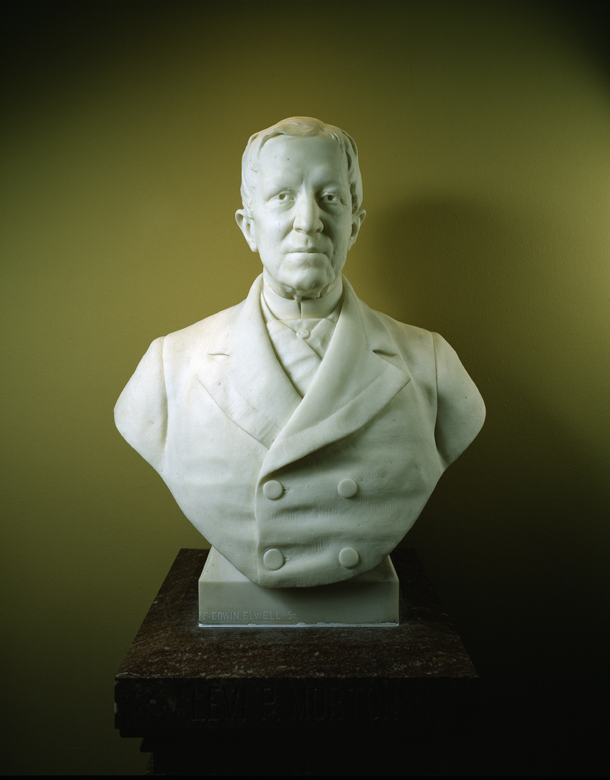
| Title | Levi P. Morton |
| Artist/Maker | Frank Edwin Elwell ( 1858 - 1922 ) |
| Date | 1891 |
| Medium | Marble |
| Dimensions | h. 35.5 x w. 28.5 x d. 15.38 in. (h. 90.2 x w. 72.4 x d. 39.1 cm) |
| Credit Line | U.S. Senate Collection |
| Accession Number | 22.00022.000 |
In 1890, with Levi P. Morton still in office, the Joint Committee on the Library included his name among vice presidents to be memorialized by marble portrait busts in the Senate Chamber. With the vice president’s approval, the committee selected Frank Edwin Elwell to execute the work. About a decade earlier, Morton had supported young Elwell’s application to attend the École des Béaux-Arts in Paris. It is likely that in 1890 Morton suggested that the sculptor be selected to produce his bust.
Born in Concord, Massachusetts, Elwell received his first instruction in art from Louisa May Alcott’s sister, Abigail May Alcott, who also taught noted sculptor Daniel Chester French. Elwell later studied under French and shared a studio with him in New York City. Elwell’s life portrait of Morton was created in New York, and placed in the Senate Chamber in 1891.
The bust seems larger than life. This impression is due to the proportions: The distance from side to side is almost equal to the distance from the top of the head to the bottom of the coat. The very simple costume–double-breasted coat, band collar, and wide cravat–is virtually identical to that worn in a photograph of Morton taken perhaps 10 years earlier. Its broad, unfussy surface and the almost pure frontality of the bust produce an effect of slightly aloof, but not stiff, dignity.
The head is remarkable for the malleable, fluctuating surface of the face. Elwell achieves a compelling evocation of an old man (Morton was 67 years old) whose soft and gently sagging skin is rendered with skillfully nuanced, almost liquid modeling. The particularity extends to his close-cropped hair, his square jaw, even to the inherent conformation of his ears.
A wealthy banker as well as a public servant, Morton was instinctively conservative; a contemporary described him as “neither intrusive nor obtrusive.” [1] That character, and his intelligence, are well served by the artist. Of interest are the deeply drilled eyeballs without elaborate highlight effects. The resulting black cavities suggest mental abstraction, or a slight reserve.
Elwell’s works are numerous and varied. He exhibited at the 1893 World’s Columbian Exposition in Chicago, and later served as curator of ancient and modern sculpture at the Metropolitan Museum of Art in New York City. Elwell is further represented in the Senate’s Vice Presidential Bust Collection by a marble bust of Garret A. Hobart.
1. Mark O. Hatfield, Vice Presidents of the United States, 1789-1993 (Washington, D.C.: Government Printing Office, 1997), 271.
Levi Parsons Morton was the 22nd vice president of the United States as well as a U.S. representative. He was born in Shoreham, Vermont, but lived most of his adult life in New York State. Having established a successful dry goods company, Morton rose to become a wealthy and influential banker in New York City. In 1878, and again in 1880, he was elected as a Republican from New York to the U.S. House of Representatives. He resigned in 1881 when President James Garfield appointed him minister to France.
Morton was elected vice president in 1888 with President Benjamin Harrison, and served one term. An 1898 biographical sketch noted that Morgan presided over the Senate "with a dignity and fairness that gained the praise of all, without regard to party distinction, even at a time when questions of party politics were most earnestly discussed." [1] Failing to win renomination to a second term, Morton returned to New York where he served as governor from 1895 to 1897. In later years he was active in real estate investment. Morton died in Dutchess County, New York, in 1920.
1. The National Cyclopaedia of American Biography, vol. 1 (New York: James T. White, 1898), 136.